Hydrometallurgical Processing of a Low-Grade Sulfide Copper–Nickel Ore Containing Pt and Pd
Abstract
:1. Introduction
2. Materials and Methods
2.1. Column Bioleaching
2.2. Sampling and Analysis
2.3. Microbial Population Analysis
2.4. Cyanidation Tests
3. Results
3.1. Bioleaching Experiments
3.2. Microbial Population Analysis
3.3. Cyanidation Tests
4. Discussion
- Availability of energy, transport infrastructure, equipment, labor resources, etc. at the location of the deposit;
- Metal prices, which continuously change due to the fluctuation of supply and demand caused by global economic and political trends;
- Available resources of valuable metals in the deposit, which can be determined by a detailed geological survey;
- Some factors that cannot be predicted before industrial-scale trials (possible environmental consequences, operating features of the selected industrial equipment, natural disasters, etc.).
5. Conclusions
Author Contributions
Funding
Data Availability Statement
Conflicts of Interest
References
- Kinas, S.; Jermakowicz-Bartkowiak, D.; Pohl, P.; Dzimitrowicz, A.; Cyganowski, P. On the path of recovering platinum-group metals and rhenium: A review on the recent advances in secondary-source and waste materials processing. Hydrometallurgy 2023, 223, 106222. [Google Scholar] [CrossRef]
- Tang, H.; Peng, Z.; Tian, R.; Ye, L.; Zhang, J.; Rao, M.; Li, G. Platinum-group metals: Demand, supply, applications and their recycling from spent automotive catalysts. J. Environ. Chem. Eng. 2023, 11, 110237. [Google Scholar] [CrossRef]
- John, D.A. Rhenium: A Rare Metal Critical in Modern Transportation; U.S. Geological Survey: Reston, VA, USA, 2015. [Google Scholar] [CrossRef]
- Chipise, L.; Ndlovu, S.; Shemi, A.; Moodley, S.S.; Kumar, A.; Simate, G.S.; Yah, C.S. Towards bioleaching of PGMS. Min. Eng. 2023, 202, 108291. [Google Scholar] [CrossRef]
- Crundwell, K.; Moats, M.S.; Ramachandran, V.; Robinson, T.G.; Davenport, W.G. Extractive Metallurgy of Nickel, Cobalt and Platinum Group Metals; Elsevier: Amsterdam, The Netherlands, 2011; 610p. [Google Scholar]
- Ivanov, A.; Alexeev, Y.; Chernykh, A.; Naumov, E.; Kulikov, D.; Tarasov, A.; Konkina, O.; Minkin, K.; Popov, I. Precious metals of the Russian Federation—The state of the mineral resource base and the prospects for its development. Otechestvennaya Geol. 2022, 1, 3–25. (In Russian) [Google Scholar] [CrossRef]
- Kuznetsov, S.K.; Burtsev, I.N.; Timonina, N.N.; Kuznetsov, D.S. Mineral resources of the Russian North. Proc. Komi Sci. Cent. Ural Branch Russ. Acad. Sci. 2022, 2, 72–83. (In Russian) [Google Scholar] [CrossRef]
- Svetlov, A.V.; Pripachkin, P.V.; Masloboev, V.A.; Makarov, D.V. Classification of substandard copper-nickel ores and technogenic mineral formations according to their environmental hazard and suitability for hydrometallurgical processing. Phys. Tech. Probl. Miner. Dev. 2020, 2, 128–136. (In Russian) [Google Scholar] [CrossRef]
- Sefako, R.; Sekgarametso, K.; Sibanda, V. Potential processing routes for recovery of platinum group metals from Southern African oxidized PGM Ores: A Review. J. Sustain. Met. 2017, 3, 797–807. [Google Scholar] [CrossRef]
- Yanishevskya, E.; Fokina, N.; Selivanova, E.; Kompanchenko, A.; Makarov, D.; Goryachev, A. Processing of sulfide copper-nickel ores from the deposits in Murmansk Region by heap leaching. Minerals 2021, 11, 820. [Google Scholar] [CrossRef]
- Latyuk, E.; Melamud, V.; Lavrinenko, A.; Makarov, D.; Bulaev, A. Non-ferrous metals and pgm recovery from low-grade copper–nickel concentrate by bioleaching and further cyanidation. Minerals 2022, 12, 340. [Google Scholar] [CrossRef]
- Mwase, J.M.; Petersen, J.; Eksteen, J.J. Assessing a two-stage heap leaching process for Platreef flotation concentrate. Hydrometallurgy 2012, 129–130, 74–81. [Google Scholar] [CrossRef]
- Mwase, J.M.; Petersen, J.; Eksteen, J.J. A novel sequential heap leach process for treating crushed Platreef ore. Hydrometallurgy 2014, 141, 97–104. [Google Scholar] [CrossRef]
- Shaik, K.; Petersen, J. An investigation of the leaching of Pt and Pd from cooperite, sperrylite and column bioleached concentrates in thiocyanate-cyanide systems. Hydrometallurgy 2017, 173, 210–217. [Google Scholar] [CrossRef]
- Johnson, D.B. The Evolution, current status, and future prospects of using biotechnologies in the mineral extraction and metal recovery sectors. Minerals 2018, 8, 343. [Google Scholar] [CrossRef]
- Medina, D.; Anderson, C.G. A Review of the cyanidation treatment of copper-gold ores and concentrates. Metals 2020, 10, 897. [Google Scholar] [CrossRef]
- Deschênes, G.; Hall, D.; Fulton, M. Cyanidation of a pyrrhotite-bearing gold ore. Eur. J. Miner. Process. Environ. Prot. 2003, 3, 353–361. [Google Scholar]
- Bakhti, A.; Moghimi, H.; Bozorg, A.; Stankovic, S.; Manafi, Z.; Schippers, A. Comparison of bioleaching of a sulfidic copper ore (chalcopyrite) in column percolators and in stirred-tank bioreactors including microbial community analysis. Chemosphere 2023, 349, 140945. [Google Scholar] [CrossRef] [PubMed]
- Roberto, F.F.; Schippers, A. Progress in bioleaching: Part B, applications of microbial processes by the minerals industries. Appl. Microbiol. Biotechnol. 2022, 106, 5913–5928. [Google Scholar] [CrossRef] [PubMed]
- van Aswegen, P.C.; van Niekerk, J.; Olivier, W. The BIOXTM process for the treatment of refractory gold concentrate. In Biomining; Rawlings, D.E., Johnson, D.B., Eds.; Springer: Berlin/Heidelberg, Germany, 2007; pp. 1–35. [Google Scholar]
- Latyuk, E.; Goryachev, A.; Makarov, D. Processing of alluvial deposit sands with a high content of copper and nickel using combined enrichment technology. Metals 2023, 13, 1493. [Google Scholar] [CrossRef]
- Chashchin, V.V.; Savchenko, Y.E.; Petrov, S.V.; Kiseleva, D.V. Platinum content and formation conditions of the sulfide PGE–Cu–Ni Nyud-II deposit of the Monchegorsk Pluton, Kola Peninsula, Russia. Geol. Ore Depos. 2021, 63, 87–117. [Google Scholar] [CrossRef]
- Bulaev, A.G.; Melamud, V.S. Bioleaching of non-ferrous metals from flotation wastes. Int. Res. J. 2018, 12, 63–71. (In Russian) [Google Scholar] [CrossRef]
- Riekkola-Vanhanen, M. Talvivaara Sotkamo mine—Bioleaching of a polymetallic nickel ore in subarctic climate. Nova Biotechnol. Chim. 2010, 10, 7–14. [Google Scholar] [CrossRef]
- Bulaev, A.; Kadnikov, V.; Elkina, Y.; Beletsky, A.; Melamud, V.; Ravin, N.; Mardanov, A. Shifts in the microbial populations of bioleach reactors are determined by carbon sources and temperature. Biology 2023, 12, 1411. [Google Scholar] [CrossRef] [PubMed]
- Gericke, M.; Govender, Y. Bioleaching strategies for the treatment of nickel–copper sulphide concentrates. Min. Eng. 2011, 24, 1106–1112. [Google Scholar] [CrossRef]
- Yang, C.; Qin, W.; Lai, S.; Wang, J.; Zhang, Y.; Jiao, F.; Ren, L.; Zhuang, T.; Chang, Z. Bioleaching of a low grade nickel–copper–cobalt sulfide ore. Hydrometallurgy 2011, 106, 32–37. [Google Scholar] [CrossRef]
- Goryachev, A.A.; Makarov, D.V.; Potapov, S.S.; Belyaevsky, A.T.; Semushin, V.V.; Kompanchenko, A.A. Processing of ore from the Nud II deposit by the method of low temperature roasting with ammonium sulfate. Vestn. MSTU 2023, 26, 137–149. (In Russian) [Google Scholar] [CrossRef]
- Petersen, J. Heap leaching as a key technology for recovery of values from low-grade ores—A brief overview. Hydrometallurgy 2016, 165, 206–212. [Google Scholar] [CrossRef]
- Tupikina, O.V.; Minnaar, S.H.; Rautenbach, G.F.; Dew, D.W.; Harrison, S.T.L. Effect of inoculum size on the rates of whole ore colonisation of mesophilic, moderate thermophilic and thermophilic acidophiles. Hydrometallurgy 2014, 149, 244–251. [Google Scholar] [CrossRef]
- Wang, X.; Forssberg, K.S.E. The chemistry of cyanide-metal complexes in relation to hydrometallurgical processes of precious metals. Miner. Process. Extr. Metall. Rev. 1990, 6, 81–125. [Google Scholar] [CrossRef]
- Muravyov, M.; Panyushkina, A.; Bulaev, A.; Fomchenko, N. Biobeneficiation of bulk copper-zinc and copper-nickel concentrates at different temperatures. Miner. Eng. 2021, 170, 107040. [Google Scholar] [CrossRef]
- Mwase, J.M.; Petersen, J.; Eksteen, J.J. A conceptual flowsheet for heap leaching of platinum group metals (PGMs) from a low-grade ore concentrate. Hydrometallurgy 2012, 111, 129–135. [Google Scholar] [CrossRef]
- Sadeghieh, S.M.; Ahmadi, A.; Hosseini, M.R. Effect of water salinity on the bioleaching of copper, nickel and cobalt from the sulphidic tailing of Golgohar Iron Mine, Iran. Hydrometallurgy 2020, 198, 105503. [Google Scholar] [CrossRef]
- Vera Véliz, M.; Videla Leiva, A.; Martínez Bellange, P. Copper bioleaching operations in Chile: Towards new challenges and developments. In Biomining Technologies; Johnson, D.B., Bryan, C.G., Schlömann, M., Roberto, F.F., Eds.; Springer: Cham, Switzerland, 2023; pp. 163–176. [Google Scholar] [CrossRef]
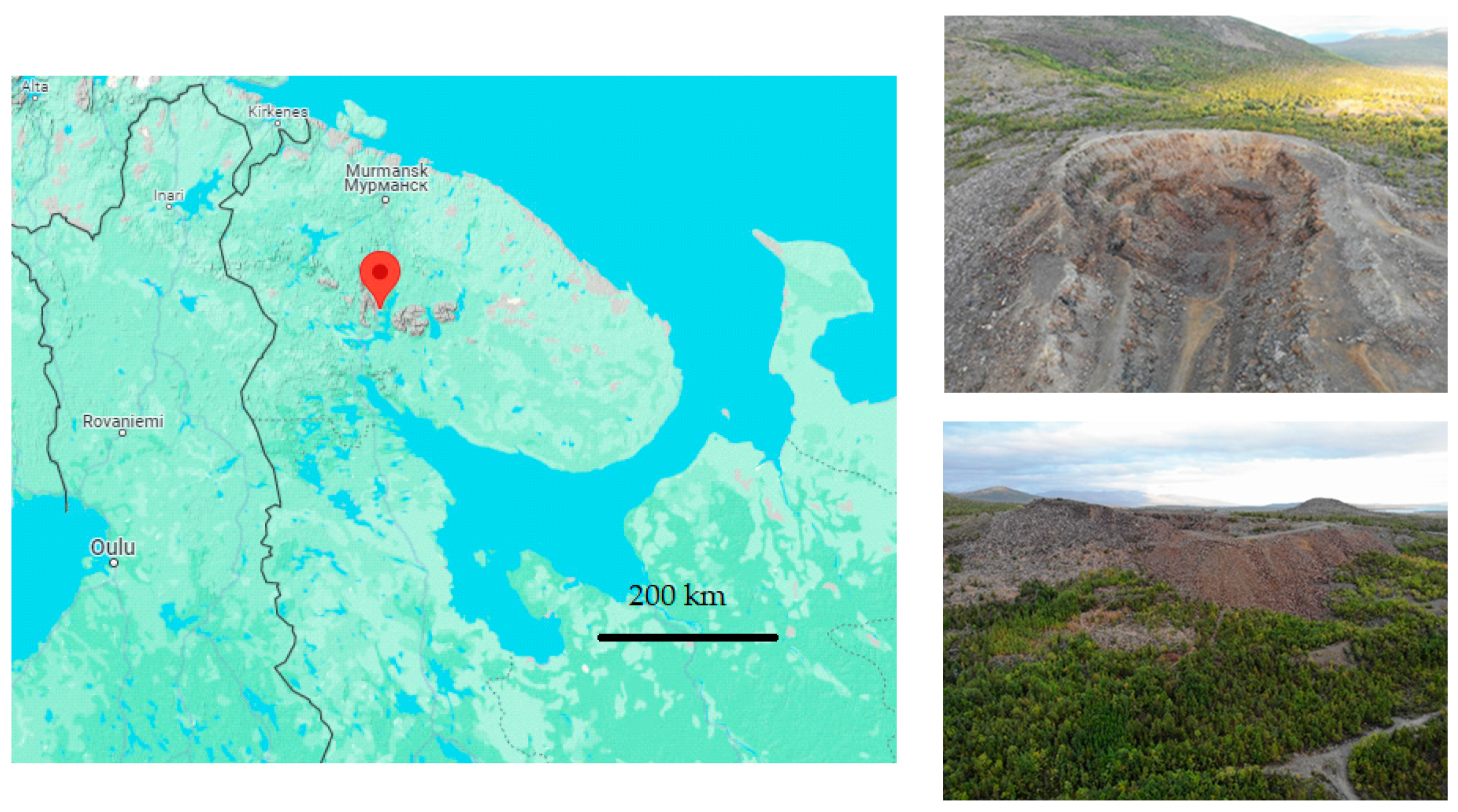
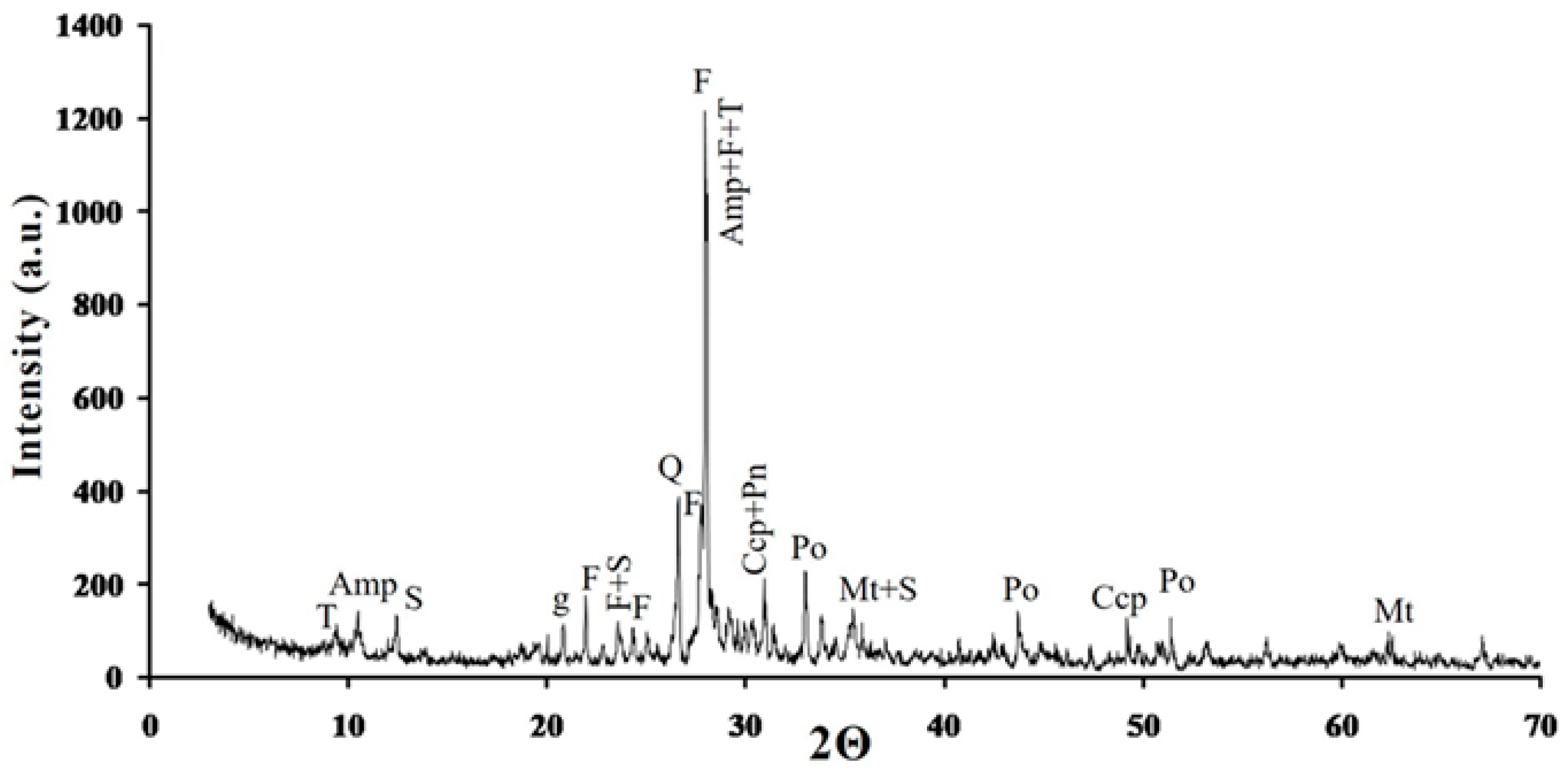
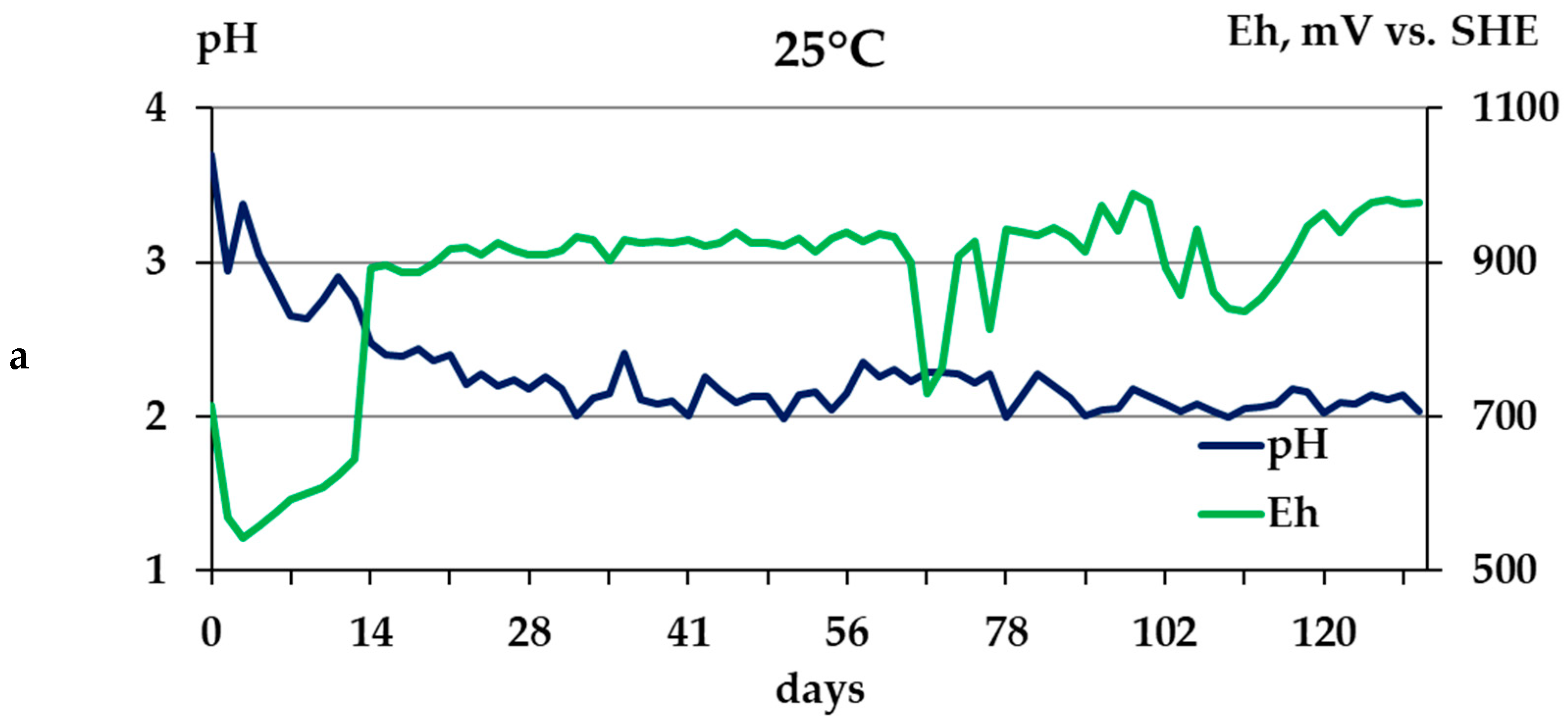



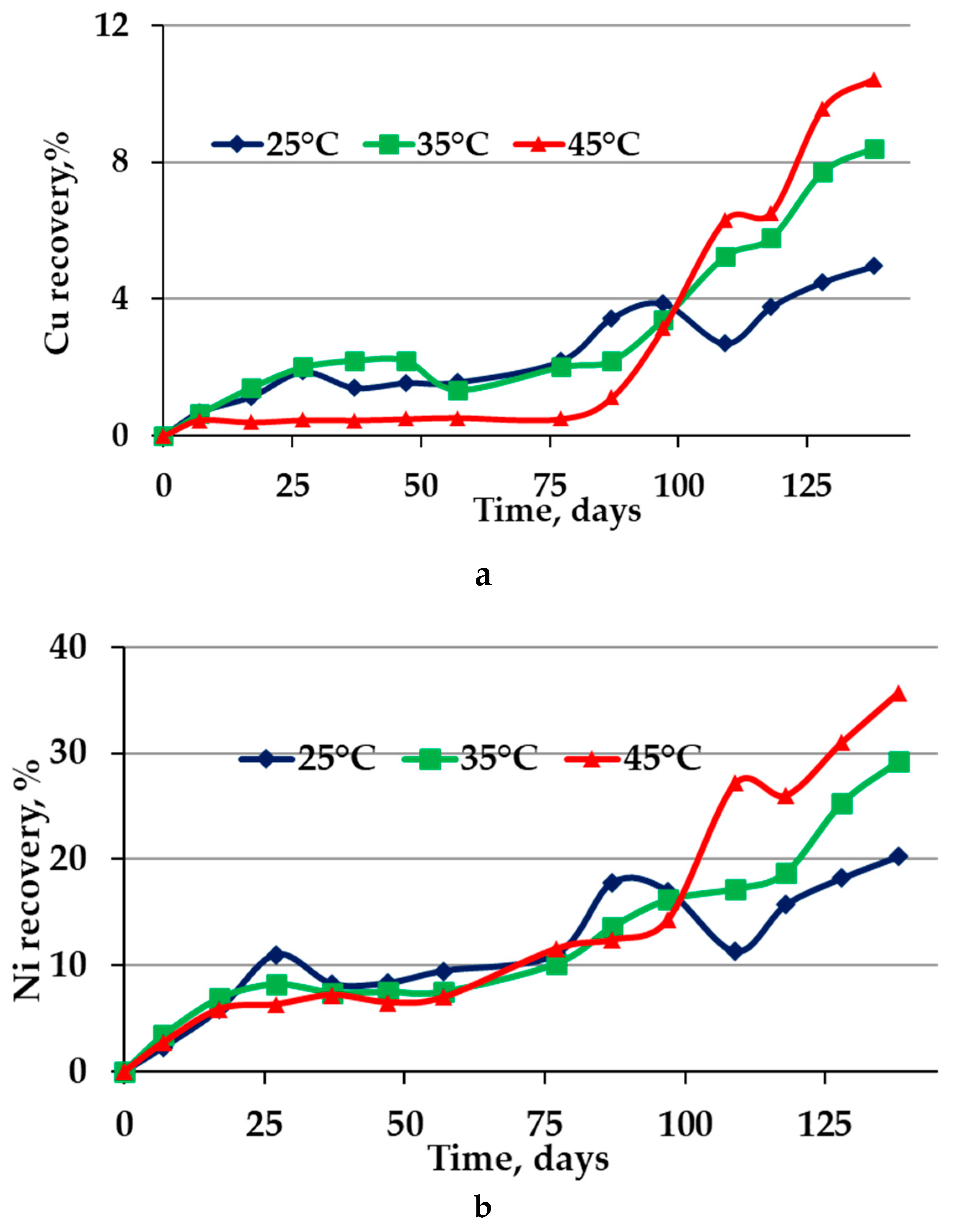

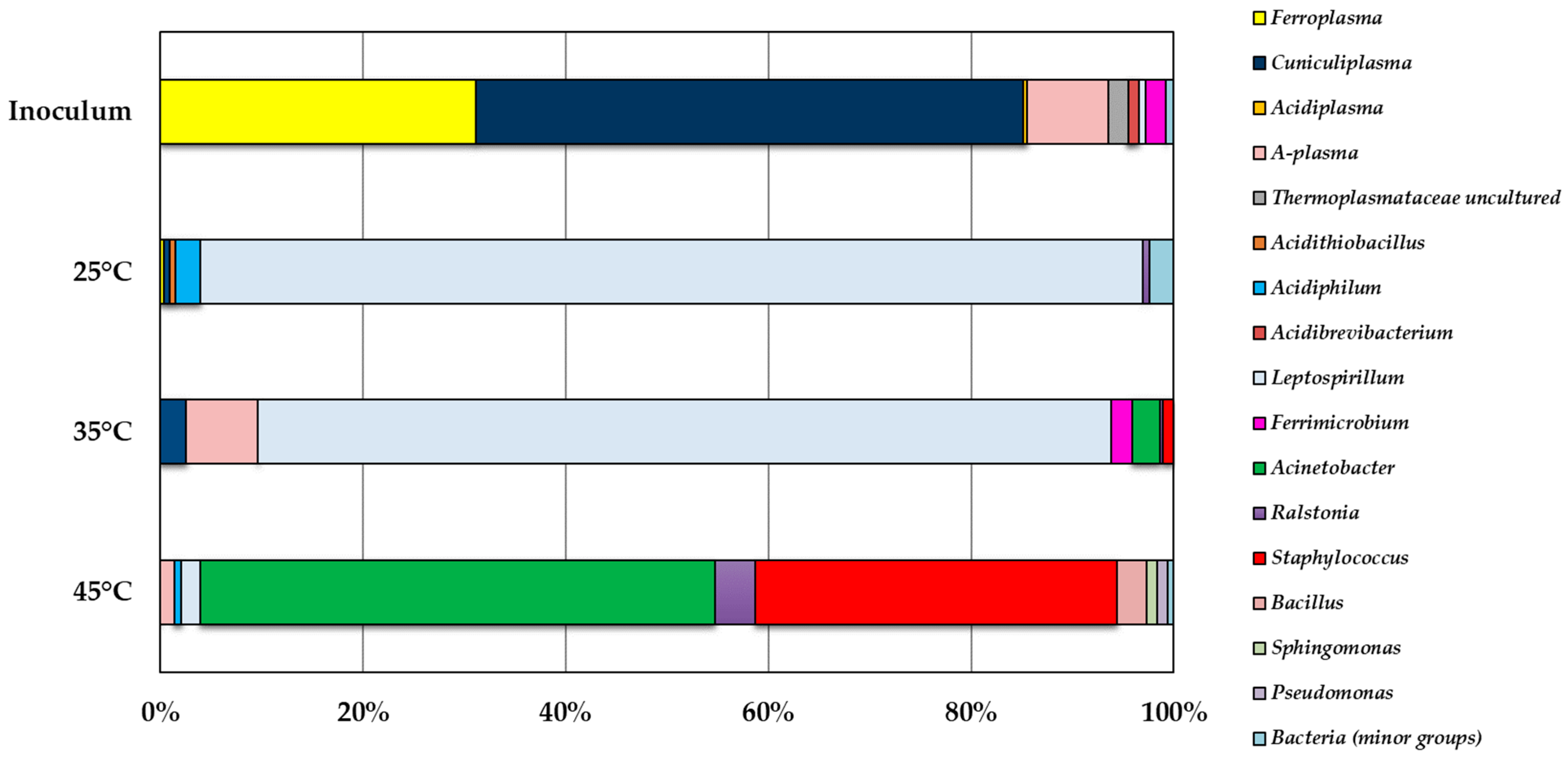
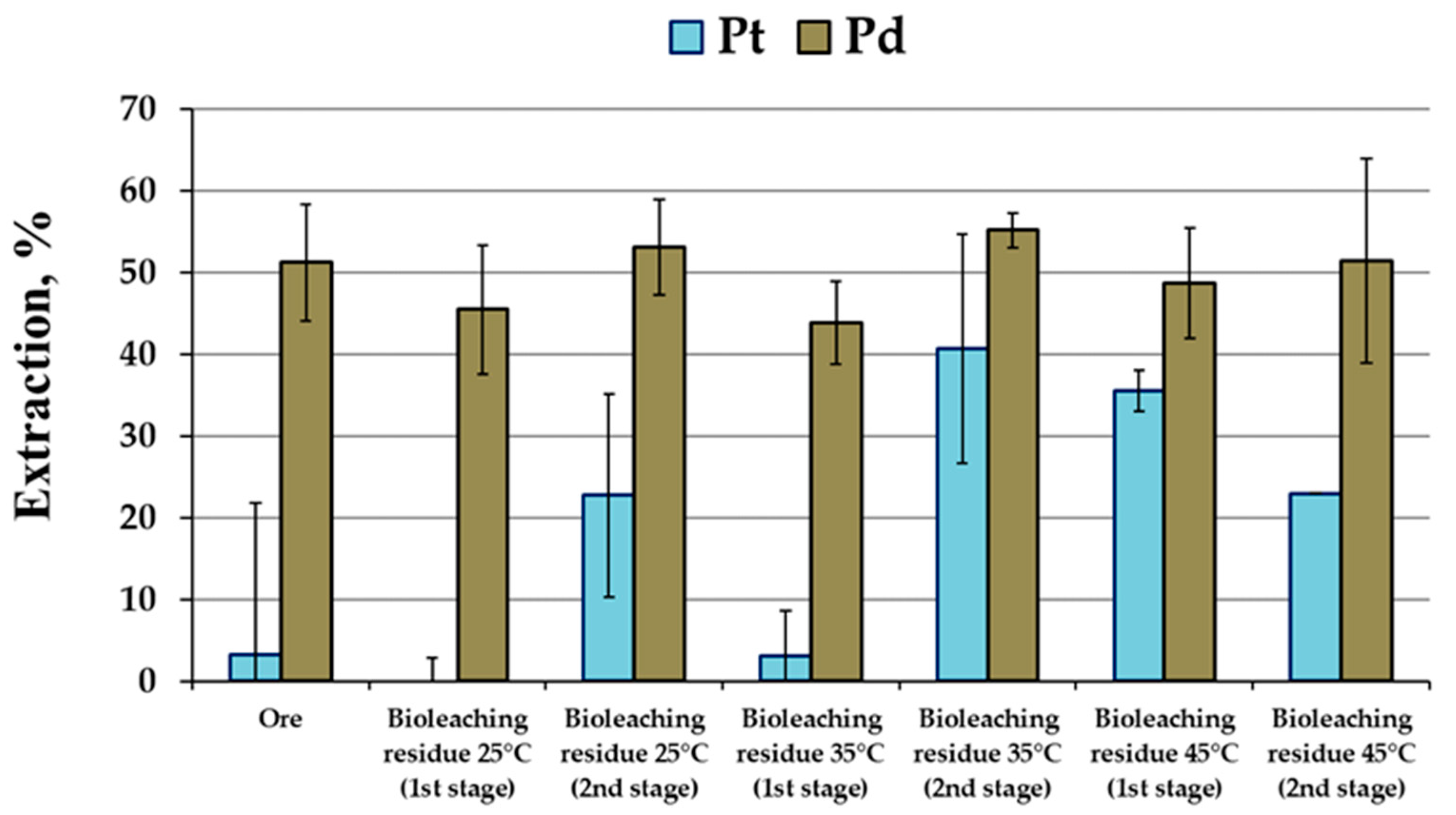
| Sample | Si | K | Ca | Mg | Al | Fe | Cu | Ni | ||
|---|---|---|---|---|---|---|---|---|---|---|
| Ore | 16.93 | 0.19 | 3.99 | 6.18 | 5.35 | 14.80 | 0.23 | 0.74 | ||
| Bioleaching residue | Stage 1 (68 days) | 25 °C | 15.44 | 0.20 | 3.68 | 5.54 | 4.93 | 12.26 | 0.22 | 0.52 |
| 35 °C | 17.09 | 0.18 | 3.69 | 6.18 | 5.28 | 12.67 | 0.19 | 0.50 | ||
| 45 °C | 13.66 | 0.17 | 3.08 | 5.05 | 4.26 | 11.48 | 0.17 | 0.44 | ||
| Stage 2 (140 days) | 25 °C | 11.63 | 0.14 | 2.32 | 4.70 | 3.92 | 8.79 | 0.11 | 0.29 | |
| 35 °C | 13.25 | 0.18 | 3.05 | 4.97 | 4.31 | 11.63 | 0.16 | 0.32 | ||
| 45 °C | 14.63 | 0.18 | 2.98 | 4.99 | 4.10 | 9.39 | 0.09 | 0.20 | ||
| Sample | Co | Zn | P | S | Mn | Cr | Ti | |||
| Ore | 0.03 | 0.01 | 0.06 | 8.10 | 0.09 | 0.07 | 0.18 | |||
| Bioleaching residue | Stage 1 (68 days) | 25 °C | 0.02 | 0.01 | 0.06 | 6.37 | 0.09 | 0.06 | 0.18 | |
| 35 °C | 0.02 | 0.01 | 0.04 | 6.43 | 0.09 | 0.06 | 0.17 | |||
| 45 °C | 0.02 | 0.01 | 0.05 | 5.16 | 0.08 | 0.07 | 0.20 | |||
| Stage 2 (140 days) | 25 °C | 0.02 | 0.01 | 0.03 | 6.02 | 0.06 | 0.04 | 0.14 | ||
| 35 °C | 0.02 | 0.01 | 0.05 | 6.74 | 0.07 | 0.05 | 0.18 | |||
| 45 °C | 0.00 | 0.01 | 0.05 | 6.01 | 0.08 | 0.06 | 0.15 | |||
| Product | Treatment | Extraction, % | Reference | |||
|---|---|---|---|---|---|---|
| Ni | Cu | Pt | Pd | |||
| Sulfide copper–nickel ore (4.25% Ni, 3.90% Cu) | Column bioleaching for 80 d at 19 °C | 16.5 | 7.5 | n.s. 1 | n.s. | [10] |
| Sulfide copper–nickel ore (1.88% Ni, 1.76% Cu) | 22.5 | 12.7 | n.s. | n.s. | ||
| Low-grade sulfide copper–nickel concentrate (0.70% Cu, 2.30% Ni, 0.1 g/t Pt, 1.35 g/t Pd | Stirred-tank reactor bioleaching for 40 d at 30 °C | 70.0 | 14.0 | n.s. | n.s. | [11] |
| Stirred-tank reactor bioleaching for 40 d at 40 °C and cyanidation | 72.0 | 34.0 | 38 | 88 | ||
| Industrial sands (0.32% Ni, 0.22% Cu) | Stirred-tank reactor bioleaching for 28 d at 30 °C | 49.1 | 39.3 | n.s. | n.s. | [22] |
| Advantage | Disadvantage |
|---|---|
| Possibility of Cu/Ni and PGM recovery | Comparatively low Cu and Pt recovery |
| Absence of the ore dressing stage and smelting | Use of cyanide solution for PGM leaching; potential leakage of bioleachate and cyanide solution |
| Comparatively low environmental impact (absence of gas emissions and low energy consumption) | |
| Comparatively simple process; high CAPEX is not required; small deposits with low-grade ores/wastes may be treated | Comparatively high duration of bioleaching |
Disclaimer/Publisher’s Note: The statements, opinions and data contained in all publications are solely those of the individual author(s) and contributor(s) and not of MDPI and/or the editor(s). MDPI and/or the editor(s) disclaim responsibility for any injury to people or property resulting from any ideas, methods, instructions or products referred to in the content. |
© 2024 by the authors. Licensee MDPI, Basel, Switzerland. This article is an open access article distributed under the terms and conditions of the Creative Commons Attribution (CC BY) license (https://creativecommons.org/licenses/by/4.0/).
Share and Cite
Latyuk, E.; Goryachev, A.; Melamud, V.; Bulaev, A. Hydrometallurgical Processing of a Low-Grade Sulfide Copper–Nickel Ore Containing Pt and Pd. Processes 2024, 12, 1213. https://doi.org/10.3390/pr12061213
Latyuk E, Goryachev A, Melamud V, Bulaev A. Hydrometallurgical Processing of a Low-Grade Sulfide Copper–Nickel Ore Containing Pt and Pd. Processes. 2024; 12(6):1213. https://doi.org/10.3390/pr12061213
Chicago/Turabian StyleLatyuk, Elena, Andrey Goryachev, Vitaliy Melamud, and Aleksandr Bulaev. 2024. "Hydrometallurgical Processing of a Low-Grade Sulfide Copper–Nickel Ore Containing Pt and Pd" Processes 12, no. 6: 1213. https://doi.org/10.3390/pr12061213





